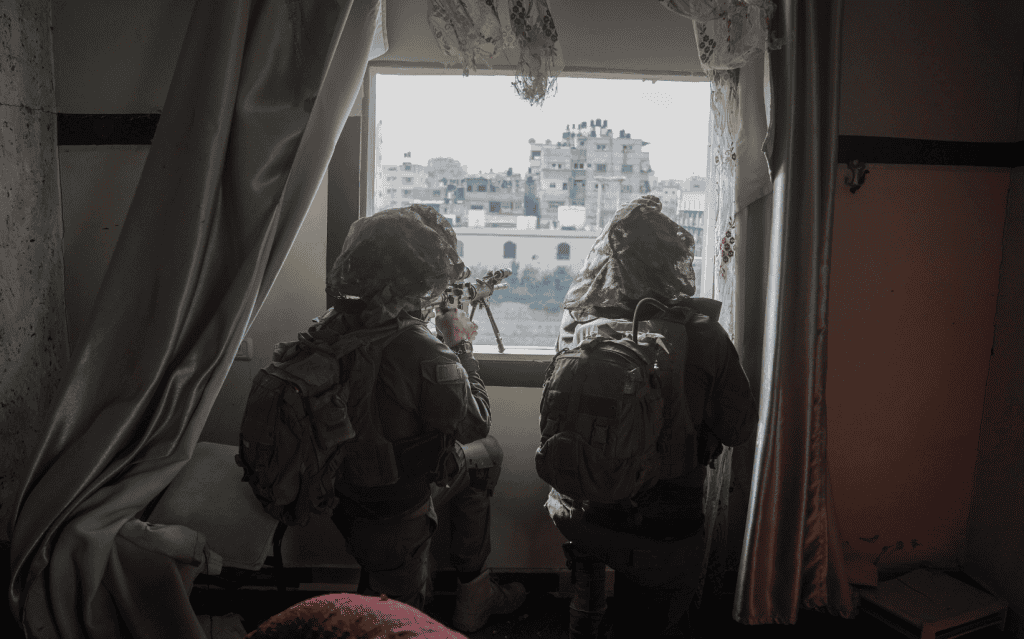
The Israel Defense Forces on December 19 targeted terror tunnels and revealed they had carried out a precision strike on a Hamas terror financier. The operations are part of the continuing attempt to strike at key nodes of Hamas’ system of control of the Gaza Strip and uproot the terrorist infrastructure that lies beneath the surface.
As part of this campaign, the IDF is also using new technology. The IDF posted a statement on December 18 about its use of the Smash fire control system, which is made by Israel’s Smartshooter. “The fire monitoring system Smash has been introduced to the battlefield during the war against Hamas. This operational support tool weighs less, identifies the enemy within seconds, can lock on targets and assist in eliminating them and quadruples our forces’ chances of hitting their target,” they noted.
The system can be used to lock on to a target, such as a drone, and control the fire on a rifle such that a bullet is released only when the target is in sight. This works for targets that are moving or during battle when there is a lot of movement. “Explosive-carrying drones and terrorists are only some of the challenges our troops are facing. In order to neutralize these threats, we must open fire,” the IDF noted. “The target doesn’t simply sit still waiting for us,” said Major Yoav, Head of the Infantry and Commando Department in the Israel Ministry of Defense’s Directorate of Defense Research and Development.
The Smash technology is integrated onto a rifle such as an M-4 and has a small computer that aids in the fire control. The IDF noted that it “calculates the data and improves the accuracy of the hit.” The IDF says this “quadruples” the chances for the soldier to hit the moving target. SmartShooter has had success in Israel as well as abroad with sales of its various defense products. The technology has been developed over the last decade. The current sights being used are more lightweight than in the past. The IDF says thousands are being used in Gaza against Hamas.
The Smash technology is not the only one Israel has highlighted in the recent conflict. The Iron Sting precision mortar system, made by Elbit Systems, has also been used for the first time in this conflict. On Friday December 15, the IDF said it struck a launch post in Lebanon using the Iron Sting. That same day, the IDF also used Iron Sting to hit a weapon storage in Khan Yunis. In addition, the IDF said that the 414th IDF battalion used a Maoz drone for the first time to strike terrorist cells in Khan Yunis. This was apparently the first time it was used by this unit, because the system has been used several times recently and was first used in Jenin in July. The Maoz is also known as the Spike FireFly, and it is a loitering munition that slams into a target but can hover overhead and wait for a target to become available. It is made by Rafael Advanced Defense Systems. Taken together, these three systems — the Smash sights, the Iron Sting and the Maoz — are all examples of precision munitions that can be used against relatively small targets.
Israeli forces have now found 1,500 terror tunnel shafts in Gaza, the IDF said on December 19. “It’s important to explain that this underground infrastructure is one of the main elements in Hamas’s terror operations,” IDF spokesperson Rear Admiral Daniel Hagari said Tuesday evening. The elite Shaldag unit is also now in operation within Hamas tunnels, the IDF specified.
Also on Tuesday, the IDF revealed that it had carried out an operation in Rafah in southern Gaza near the Egyptian border, eliminating Subhi Ferwana, a Hamas operative alleged to be a “prominent financier.” In another investigation by Israel’s intelligence service, the director of the Kamal Adwan hospital in Gaza admitted “that Hamas has turned hospitals into military facilities under their control.” Together, the targeting of a financier and investigation of Hamas’ use of hospitals along with sending elite units into tunnels showcases the challenges the IDF faces in dismantling the multifaceted nature of Hamas’ control of Gaza.
Israel also continued to face threats from Hezbollah on December 19, with Israeli air defenses downing a drone that threatened communities in the Huleh Valley in northern Israel. In addition, the deaths of two more IDF soldiers in Gaza were announced, bringing the total IDF death toll to 464 since Hamas attacked Israel on October 7.







